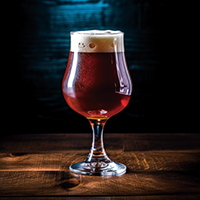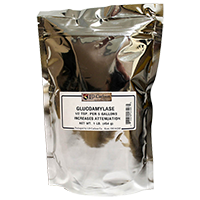Like Drier and Crisper Beers? Glucoamylase Enzyme Might Be your New BFF
Posted by Matteo Lahm on 9th Jun 2023
Have you ever wondered how to unlock the fullest potential of the sugars in your malted barley? Glucoamylase enzyme may be the secret ingredient your home brewing process has been missing if you like drier, crisper, and higher ABV beers. In certain beer styles, it brings a lot of value to your ferment. Not only does it bring characteristic advantages, using glucoamylase can be more cost-effective than adding more malted sugar, as it allows you to extract more fermentable sugars from the existing grains in your mash. As a dedicated home beer maker, allow us to unravel the mystery of this enzyme, explain how you can effectively incorporate it into your brewing techniques, and explore the benefits it offers.
So, what exactly is glucoamylase enzyme? Let us delve into the science behind it. This fascinating enzyme is responsible for breaking down the long-chain carbohydrates, like starch, into fermentable sugars, specifically glucose. Originating from a variety of microbial and fungal sources, like Aspergillus Niger and Rhizopus, glucoamylase has long been used to transform complex carbohydrates into simple sugars, making it a vital catalyst in the world of brewing.
Now that you know what our little friend glucoamylase does, you might be wondering—how can you incorporate it into your brewing venture? Cost-effectiveness: Using glucoamylase can be more cost-effective than adding more malted sugar, as it allows you to extract more fermentable sugars from the existing grains in your mash. Here are a few simple steps to help you unlock the hidden sugars in your brewing process:
1. Use the right amount: The most common glucoamylase dosage for home brewing is around 0.1 to 0.3 mL per gallon of wort. However, it's always a good idea to follow the manufacturer's recommendations, as the enzyme concentration may vary.
2. Timing is everything: Add the glucoamylase enzyme to your wort during the mash or fermentation stage. If you choose to add it during the mash, make sure the temperature is between 140°F and 160°F (60°C and 71°C) to ensure optimal enzyme activity. If you prefer to add it during fermentation, wait until the primary fermentation has slowed down, and then mix it in gently.
Why would you want to add it later? Adding glucoamylase later in the brewing process can help you achieve more residual sugars in your beer. If you want a sweeter beer with more body and mouthfeel, you can delay the addition of glucoamylase or even choose not to use it at all.
By adding glucoamylase later, you allow the yeast to consume the readily available fermentable sugars first. Once the primary fermentation has slowed down, you can then introduce the enzyme to break down the remaining complex carbohydrates into simpler sugars. This approach gives you more control over the final gravity and sweetness of your beer.
However, it's essential to strike a balance between the desired sweetness and the risk of over-fermentation. Adding glucoamylase too late in the process may result in incomplete fermentation, leaving your beer overly sweet and potentially unstable. Monitoring the gravity of your wort and tasting it periodically can help you determine the optimal time to add the enzyme.
3. Patience is a virtue: Give the enzyme enough time to work its magic. Depending on the temperature and the amount of enzyme used, it may take anywhere from 24 hours to a week for the glucoamylase to break down the complex carbohydrates into fermentable sugars.
Now that you know how to use glucoamylase enzyme, let's explore the advantages of incorporating it into your beer-making process:
1. Boost your alcohol content: By breaking down complex carbohydrates into fermentable sugars, glucoamylase increases the amount of sugar available for yeast to consume, resulting in a higher alcohol content in your final product.
2. Create a drier, crisper beer: Glucoamylase can help you achieve a lower final gravity, which means less residual sugar in your beer. This results in a drier, crisper taste that many beer enthusiasts appreciate.
3. Enhance the mouthfeel: By breaking down the long-chain carbohydrates, glucoamylase can improve the mouthfeel of your beer, making it smoother and more enjoyable to drink.

Glucoamylase enzyme can be useful in various beer styles, particularly those that benefit from a higher level of fermentable sugars, a drier finish, or a lower final gravity. Some beer styles where glucoamylase can be especially beneficial include:
1. Brut IPA: This relatively new beer style is known for its dry, champagne-like finish and high attenuation. Glucoamylase can help break down complex carbohydrates into fermentable sugars, resulting in a lower final gravity and a drier, crisper beer.
2. Saison: Saisons are traditionally dry and highly attenuated farmhouse ales. Using glucoamylase can help achieve the desired dryness and high attenuation, enhancing the beer's overall character.
3. Belgian Tripel: This strong, pale ale typically has a high alcohol content and a dry finish. Glucoamylase can help increase the fermentable sugars, boosting the alcohol content and ensuring a drier finish.
4. Imperial Stout: While Imperial Stouts are generally known for their rich, full-bodied character, some brewers may want to create a drier version with a higher alcohol content. Glucoamylase can help achieve this by breaking down complex carbohydrates into fermentable sugars.
5. Gluten-free beers: For those brewing gluten-free beers using alternative grains like sorghum, millet, or rice, glucoamylase can be particularly useful. These grains often have a higher starch content and may require additional enzymes to break down the complex carbohydrates into fermentable sugars.

6. High-gravity beers: Beers with a high original gravity, such as Barleywines or Double IPAs, can benefit from glucoamylase to ensure complete fermentation and prevent the beer from becoming overly sweet or cloying.
While glucoamylase can be beneficial in these beer styles, it's essential to remember that its use depends on the brewer's preferences and desired outcomes. Some brewers may choose not to use glucoamylase in certain styles to maintain a sweeter, fuller-bodied beer. Ultimately, the decision to use glucoamylase depends on the specific goals and desired characteristics of the beer being brewed.
So is glucoamylase enzyme necessary for every home brewer? The answer is no. Many all-grain brewers can achieve satisfactory results without the use of additional enzymes. However, if you're looking to push the boundaries of your brewing process, glucoamylase can be a valuable tool in your arsenal.
In conclusion, while glucoamylase enzyme may not be an essential ingredient for every home beer maker, it offers a range of benefits that can elevate your brewing game. By understanding what it is, how to use it, and the advantages it provides, you can make an informed decision about whether to incorporate this powerful enzyme into your beer-making process. So, go ahead and experiment with glucoamylase enzyme, and let your creativity flow as you craft the perfect brew! Cheers!


